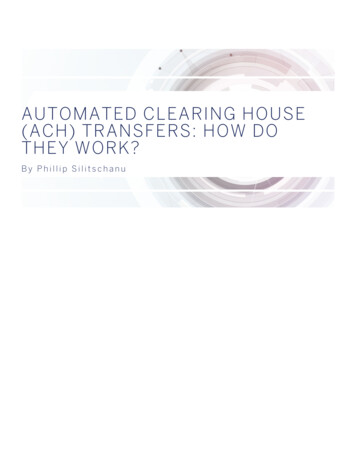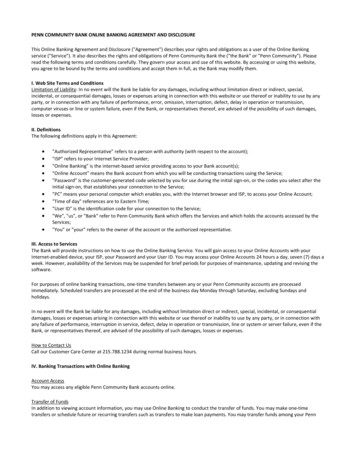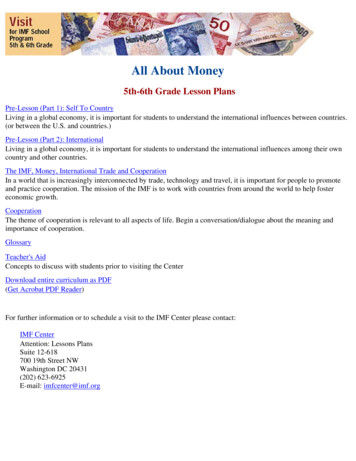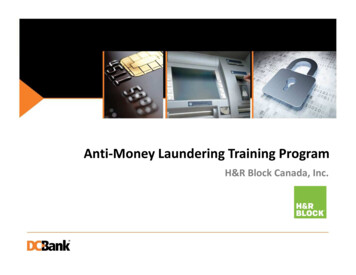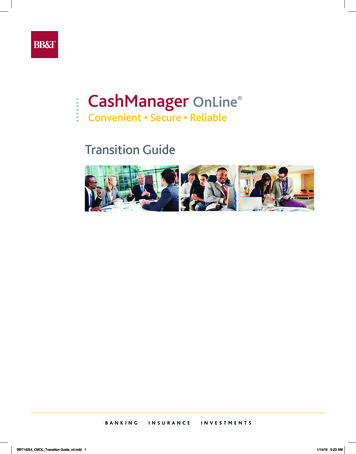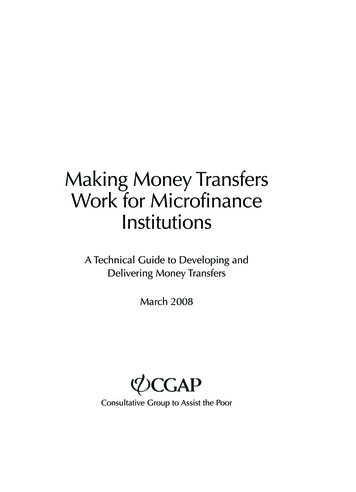
Transcription
Making Money w-sidebars 6.12.086/20/0812:00 PMPage 1Making Money TransfersWork for MicrofinanceInstitutionsA Technical Guide to Developing andDelivering Money TransfersMarch 2008Consultative Group to Assist the Poor
Making Money w-sidebars 6.12.086/20/0812:00 PMPage 1Making Money TransfersWork for MicrofinanceInstitutionsA Technical Guide to Developing andDelivering Money TransfersMarch 2008Consultative Group to Assist the Poor
Making Money w-sidebars 6.12.086/20/0812:00 PMPage 2Making Money Transfers Work for Microfinance Institutions: ATechnical Guide to Developing and Delivering Money Transfers isavailable for download from the CGAP Web site(http://www.cgap.org/) publications page. 2007 Consultative Group to Assist the Poor/The World BankAll rights reserved.Consultative Group to Assist the Poor1818 H Street, N.W.Washington, DC 20433Internet: www.cgap.orgEmail: cgap@worldbank.orgTelephone: 1.202.473.9594
Making Money w-sidebars 6.12.086/20/0812:00 PMPage 3Table of ContentsAcknowledgments9Foreword11Executive Summary13This Guide15Chapter 1: Opportunities in the Money Transfer Market17The Money Transfer Market17Chapter 2: How Money Transfers Work22Payment Instruments22Money Transfer Value Chain22Marketing and Selling Tranfers Products23Originating and Funding25Selecting the Transfer Mechanism25Funding the Money Transfer25Originating the Transfer26Sending, Clearing, and Settlement of Transfer Orders26Receiving a Money Transfer Order28Paying a Money Transfer Order30Customer Service30Chapter 3: Business Models for Money Transfers32Direct Approach36Partnerships39Single Partnership40Multiple Partnership41Potential PartnersMoney Transfer CompaniesSmall Money Transfer Companies424245
Making Money w-sidebars 6.12.086/20/08412:00 PMPage 4Making Money Transfers Work for Microfinance InstitutionsBank Partners45Consortium Approach47Chapter 4: Developing a Money Transfer Business49Taking Stock49Environment50Internet Assessment52Setting Strategy52Goal Setting53Determining Competitive Advantage53The Right Product and the Right Market55Developing Transfer Products58Product Development59Client Preferences61Pricing63Promoting Products64Creating Institutional Capacity66Developing a Money Transfer Policy66Establishing Delivery Channels70Managing the Risks71Money Management Chanllenges72Information Management Challenges75Client Service Challenges75Payment Medium Challenges77Compliance Challenges79Partnership Challenges80Chapter 5: Negotiating Partnerships83The Two Sides of the Table83The Money Tansfer Company’s PerspectiveWhat the MTC Looks for in a PartnerThe MFI’s Perspective838385What the MFI Should Know About a Partner85Stage One: Gather Information and Rank Potential MTC Partners86
Making Money w-sidebars 6.12.086/20/0812:00 PMPage 5Table of ContentsStage Two: Contact Potential Partners and Perform Due Diligence588Requesting additional information from the MTC88Provide Information88Stage Three: Negotiate Contract89Discuss Strengths90Negotitate Commission Terms90Negotiate Other Terms91Concluding Thoughts93Annex 1: The Building Blocks of Retail Money Transfers:Payment Systems and Payment Instruments94Transferring Funds94Fund Transfer Types96Retail Payment Systems97Payment Instruments99Cash-based Payments and Transfers99Paper-based Payments and Transfers100Card-based Payments and Transfers103Electronic Payments and Transfers108Annex 2: Formality of Financial Channels115Formal Financial Channels115Semiformal Financial Channels115Informal Channels116Annex 3: General Principles for International Remittance Service119The General Principles120Annex 4: Tracking Stock Checklist123Annex 5: Selecting a Partner: Quick Reference128
Making Money w-sidebars 6.12.0866/20/0812:00 PMPage 6Making Money Transfers Work for Microfinance InstitutionsReferencesWeb sites for more information on money transfers131134List of TablesTable 1: Client preferences in money transfer services62Table 2: Uses of fund transfers95Table 3: Payment media and their corresponding money type98Table 4: Credit, debit, and prepaid cards: a comparison107Table 5: Summary: Advantages and disadvantages of moneytransfer mechanisms for customers and financial service partners114List of BoxesBox 1: Send-side marketing by Fonkoze in Haiti23Box 2: Fonkoze offers stored-value cards29Box 3: Pursuing several models: Guatemala’s Banrural33Box 4: Postal networks offer a variety of money transfer options34Box 5: Direct payment system in the Philippines and El Salvador36Box 6: National Microfinance Bank of Tanzania:The dominant player in the domestic transfer market37Box 7: Fonkoze expands remittance options39Box 8: IRnet for credit unions43Box 9: Cambodia’s ACLEDA Bank and its correspondentbanking activities46Box 10: GiroNil shared money transfer platform in Egypt47Box 11: Bansefi: A network for MFIs48Box 12: WIZZIT: New possibilities, but also new challenges54Box 13: ARB/Ghana57Box 14: SMEP provides banking services to Kenyans throughmobile phones66Box 15: An established MFI’s experience withAML/CFT compliance68Box 16: Sharded branching: Expanding points of service71Box 17: Physical security in rural areas: AMUCSS’ experience73
Making Money w-sidebars 6.12.086/20/0812:00 PMPage 7Table of ContentsBox 18: G-Cash and SMART Money776Box 19: Alianza’s prepaid debit card and “open”remittance delivery networkBox 20: Managing risks7881Box 21: AMUCSS-Envíos Confianza: A grassrootsconsortium for rural MFIsBox 22: Protecting the MFIs interests by analyzing the full costs8490Box 23: Enabling affordable, card-based international remittances 104Box 24: G-Cash in the Philippines112Box 25: Hawalas” A sophisticated, informal channel117List of FiguresFigure 1: Large countries receive more remittances in raw18volume, but small countries receive the most in remittanceswith respect to their GDPFigure 2: Rich countries are the largest sources of remittanceto developing countries in dollar terms19Figure 3: Value chain for the money transfer business22Figure 4: Clearing and settlement of money transfers27Figure 5: Estimated market share of intenational person-toperson transfer providers, 200344Figure 6: SWOT Matrix50Figure 7: Porter’s generic strategies53Figure 8: Product-market matrix55Figure 9: Systematic product development process59
Making Money w-sidebars 6.12.086/20/0812:00 PMPage 8
Making Money w-sidebars 6.12.086/20/0812:00 PMPage 9AcknowledgmentsJennifer Isern (CGAP) led the development of this technical guide on moneytransfers. The authors are Isern, William Donges, and Jeremy Smith. JasminaGlisovic-Mezieres (CGAP) provided useful research assistance. The technical guide was edited by Chris Jarzombek and Paul Holtz.Launched in October 2005, the advisory group for this initiative advisedon the initial concept and reviewed annotated outlines of the manual.Advisory Group members included Vanessa Vizcarra Bianchi (MFIC),Massimo Cirasino (World Bank), Anna Cora Evans (WOCCU), José AntonioGarcia Luna (World Bank), Dave Grace (WOCCU), Gautam Ivatury(CGAP), Tom Jahnes (Western Union), Tim Lyman (CGAP), Manuel Orozco(Inter-American Dialogue), Doug Pearce (DFID), Valsa Shah (DFID), andGregory Watson (Inter-American Development Bank).Isern, Grace, and Glisovic-Mezieres designed the CGAP e-conference onmoney transfers in March 2006. Grace facilitated this five-dayconference,which addressed operational issues for MFIs offering moneytransfer services. The e-conference was co-sponsored by CGAP, the WorldCouncil of Credit Unions (WOCCU), the International Fund for AgriculturalDevelopment (IFAD), and the Inter-American Development Bank(IADB)/Multilateral Investment Fund (MIF).A draft of this document was released in December 2006 for public comment. Maria Jaramillo (ACCION), Grace (WOCCU), Anne Hastings(Fonkozé/Haiti), Antonio Garcia Luna (World Bank), Massimo Cirasino(World Bank), Vizcarra Bianchi (MFIC), and Ignacio Mas (CGAP) provideddetailed comments to the technical guide. In addition, the authors are grateful for helpful comments and contributions of text boxes from AlexBerthauud (AMUCSS/Mexico), Peter Van Roosmalen (Inclusion Group),Phyllis Mbungu (SMEP/Kenya), Randy Gutierrez (Alianza International),Julio Vega (Foreign Ministry of Peru), Ben Knoll (Grupo Express), ArunKashyap (UNDP), Tom Jahnes (Western Union), and Martin Alsop (DFID).
Making Money w-sidebars 6.12.086/20/0812:00 PMPage 10
Making Money w-sidebars 6.12.086/20/0812:00 PMPage 11ForewordThe Consultative Group to Assist the Poor (CGAP) produced Making MoneyTransfers Work for Microfinance Institutions to help financial serviceproviders determine whether offering money transfer services is in their interests. And if so, to help them determine what strategy, products, and institutional structure are needed to support a successful money transfer operation.CGAP welcomes comments or questions on this publication (mailingaddress: 1818 H Street N.W., Washington, DC 20433, USA; fax 202-5223744).Elizabeth LittlefieldChief Executive OfficerConsultative Group to Assist the Poor
Making Money w-sidebars 6.12.086/20/0812:00 PMPage 12
Making Money w-sidebars 6.12.086/20/0812:00 PMPage 13Executive SummaryMoney transfers, including international remittances, are a growing globalmarket. In 2006, formally recorded international remittances exceededUS 300 billion. And it is believed that informal remittances (those that areuntracked or that go through nonlicensed institutions) may be as high as anadditional 150 billion.Because of the growing market and potential for profit, companies ofall types are entering the money transfer market. Given the necessary infrastructure, this includes not only formal banking institutions, but also telecoms, software and hardware companies, and governments that recognizethe need for regulation as well as an opportunity to extend public services.Likewise, this market presents a unique opportunity for MFIs to growand extend not only their business, but also their mission. MFIs that alreadyserve low-income clients are well placed to expand their services; many MFIsare located in areas where few others offer money transfers. If designed well,money transfers can be a valuable financial service for clients, and they canbring additional revenue for the MFI.However, a poorly designed or poorly implemented transfer service canoverwhelm the MFI with problems and can become unprofitable. An MFIshould not simply decide to offer a transfer product, it must first understandthe mechanics of transfers (such as how funds move from sender to settler toreceiver) and the environment in which it hopes to offer the product.The money transfer market is complicated. It is constantly changing andgrowing as new players enter. The MFI must undergo critical self-examination to determine whether it is ready to handle the impact of the new service. Offering money transfers requires significant development in all areas ofbusiness, including human resources, internal systems, customer service,marketing, regulation, and risk management. Indeed, providing a moneytransfer service can radically alter the way an MFI operates.
Making Money w-sidebars 6.12.08146/20/0812:00 PMPage 14Making Money Transfers Work for Microfinance InstitutionsPartnering with a more established money transfer company (MTC) isoften the best course of action, because a partnership can offer the MFI atested blueprint and help dealing with obstacles. But partnerships come withtheir own risks, and no relationship is guaranteed to be successful.Despite significant challenges, MFIs of all shapes and sizes have enteredthe market and created a multifaceted environment. From one-on-one relationships to large consortia, MFIs have found numerous ways to leverageweaknesses into strengths. From banking by phone to virtual banks, MFIsare offering new and more creative products and services all the time. Wellinformed MFIs that have entered the money transfer business thoughtfullyhave discovered that the risks are worth the rewards, both to their bottomline and to the lives of their clients.
Making Money w-sidebars 6.12.086/20/0812:00 PMPage 15This GuideAlthough the money transfers market offers tantalizing opportunities for financial service providers, the risks can be high. The purpose of Making MoneyTransfers Work for Microfinance Institutions is to help financial serviceproviders determine whether offering money transfer services is in their interests. And if so, to help them determine what strategy, products, and institutionalstructure are needed to support a successful money transfer operation.This guide is primarily written for use by financial service providers, suchas MFIs and other institutions that serve low-income clients. MFIs aredefined as financial cooperatives, nongovernmental organizations (NGOs),specialized financial institutions, nonbank financial institutions, savings andpostal banks, and others. The guide seeks to help senior managers and directors launch new money transfer services or improve existing ones. However,policy makers, regulators, funders, and others involved in the money transfers market may also benefit from this guide.This guide is organized into five chapters, with the first half of the guidebeing informative (what is the money transfer business?) and the second halfbeing directive (starting a money transfer business).“Chapter 1: Opportunities in the Money Transfer Market” provides anoverview of the market, with particular emphasis on recent trends in financial remittances.Formal money transfers involve a complex process from sender to receiver.“Chapter 2: How Money Transfers Work” explains the process in detail.MFIs can choose from a variety of business models. “Chapter 3: BusinessModels for Money Transfers” describes the basic business models for MFIsinvolved in money transfers and examines their advantages and disadvantages.Beginning a successful money transfer business involves rethinking current practices or creating new ones. “Chapter 4: Developing a MoneyTransfer Business” provides a guideline for setting strategic goals, a processfor evaluating the MFI’s preparedness for entering the market, and an outline for developing an appropriate infrastructure.The purpose ofthis TechnicalGuide is to helpfinancial serviceproviders determine what strategy, products, andinstitutionalstructure areneeded to supporta successfulmoney transferoperation.
Making Money w-sidebars 6.12.08166/20/0812:00 PMPage 16Making Money Transfers Work for Microfinance InstitutionsAlliances that allow MFIs to offer money transfer services may be the bestapproach for new market entrants. The customer base, location, and existing distribution infrastructure of MFIs can make them attractive partners forinternational money transfer operators. The international operator’s network, foreign exchange access, and risk management expertise can, in turn,reduce both the cost and risk of an MFI’s market entry. “Chapter 5:Negotiating Partnerships” provides explicit instructions on crafting favorable alliances.These chapters are supplemented with material on the concepts discussedin this guide. “Annex 1: The Building Blocks of Retail Money Transfers:Payment Services and Instruments” serves as a primer on money transfers.Readers who are unfamiliar with money transfers are strongly encouragedto review Annex 1 before reading the main chapters, because it provides definitions and background on terminology used in this guide. “Annex 2:Formality of Financial Channels” offers a comparison, along with examples,of formal, semi-formal, and informal financial channels. “Annex 3:Summary: General Principles for International Remittance” provides guidelines for creating better markets for financial remittances developed by theWorld Bank and the Bank for International Settlements Committee onPayments and Settlement Systems. “Annex 4: Taking Stock Checklist” is atool MFIs can use to evaluate their strengths and weaknesses before enteringthe money transfer market. Similarly, “Annex 5: Selecting a Partner: QuickReference Guide” provides a simple checklist of information to considerThe field ofmoney transfersis broad andchanging rapidly.when evaluating a partner.While this guide strives for completeness, the field of money transfers isbroad and rapidly evolving. Each MFI should compare the information presented herein with the realities of its own markets.
Making Money w-sidebars 6.12.086/20/0812:00 PMPage 171Opportunities in the Money Transfer MarketFinancial service providers that cater to the poor have been drawn to the moneytransfer market because it offers them the opportunity to fulfill their financialgoals and their social objectives. As a fee-based product, money transfers can generate revenues and bolster the bottom line. Because microfinance institutions(MFIs) often serve low-income clients and clients in underserved geographicareas, money transfers help MFIs meet their social goals by delivering an additional service demanded by low-income customers—often at a cost lower thanthat of mainstream providers (Isern, Deshpande, and van Doorn 2005).Banking access rates are still quite low globally and lowest in Africa,where only one in five people has access to a bank account. In a recent survey of Latin America, only one-third of money transfer recipients use a bankaccount (Orozco 2006). Given such low levels of bank use among moneytransfers clients and MFI penetration into unbanked markets, MFIs areuniquely situated to capitalize on the market for money transfers.THE MONEY TRANSFER MARKETThe money transfer industry comprises a vast array of players for both internationaland domestic payments. In 2001, worldwide cross-border payments exceededUS 330 trillion; this is projected to grow to 604 trillion by 2011. As of 2001,domestic payments worldwide were estimated at 1,447 trillion. They are expectedto increase to 2,417 trillion by 2011 (Boston Consulting Group 2003). The flowsof international transfers from migrants, or international remittances, historicallyhave been uncounted and even ignored in official statistics. In 2006, officiallyrecorded statistics from central banks estimated that international migrant remittances reached 206 billion. However, it is widely recognized that the actual flowsmight be undercounted by 50 percent. A 2007 independent study by the multidonorFinancing Facility for Remittances (FFR)1 estimates that in 2006 the overall international remittance flows (both formal and informal) to developing countriesreached 300 billion, suggesting more than 1.5 billion transactions of 100, 200,or 300 at a time. By all accounts, available data indicate a very large market.1FFR is a multidonor fund composed of the International Fund for Agricultural Development, CGAP, theEuropean Union, the MIF of the Inter-American Development Bank, UNCDF, the Government of Spain, andthe Government of Luxembourg. FFR is housed at IFAD headquarters in Rome. For more information, m.The money transfer market offersthe opportunity tofulfill financialgoals as well associal objectives.
Making Money w-sidebars 6.12.08186/20/0812:00 PMPage 18Making Money Transfers Work for Microfinance InstitutionsRemittances constitute one of the largest sources of external funding fordeveloping countries, in most cases dwarfing the amount of official development assistance (ODA). Figures for 2006 show that international remittancesto Africa totaled US 38 billion, the equivalent of all foreign direct investment(FDI) to Africa. Remittances were the equivalent of 80 percent of all FDIflows to developing countries in Eastern Europe. Likewise, remittances werea significant portion of GDP for Asia ( 114 billion), LAC ( 68 billion), andthe developing economies of the Near East ( 28 billion).2Money transfersare attractingincreasing attention from theprivate sector,governments,and developmentagencies.Such staggering global volumes, remittances, and other types of moneytransfers are attracting increasing attention from the private sector, governments, and development agencies. The money transfers market includes alltypes of customers, including individuals, businesses, and governments. Forboth international and domestic money transfers, clients from all levels ofsociety use a variety of services, including formal, highly regulated channelsand informal, unregulated ones (Isern, Deshpande, and van Doorn 2005).Money transfers are used by people for many purposes: from everyday billpayment, to one-time-only money needs, to delivering money from people inmore-developed countries to families back home (remittances).Figure 1: Large countries receive more remittances in raw volume, but small countriesreceive the most in remittances with respect to their GDP.*Remittances by Volume(US billion)Remittances as Percentage of GDP454035302525201520151050105IndM iaexicoRus Ph Chinisian lipp aFe inede sratU ionkBa rang ineladeTu shrkeyBraVizet ilNam0Sã Go T uinom eaé -Bian ssdPr auincipEr eWites Ta reat B jikan istk o anfGazaCLM ap aooldo e V sva erd,R eKy eprg ofyzstaG nrenda30*Adapted from Funding Facility for Remittances 2007.2OECD estimates US 103.9 billion in aid in 2006 from the world’s major donors to developing countries worldwide (OECD 2006).
Making Money w-sidebars 6.12.086/20/0812:00 PMPage 1919Opportunities in the Money Transfer MarketAmong money transfer products, international remittances have received themost attention. The top three recipients of international remittances in 2006were India (US 24,504 million), Mexico ( 24,354 million), and China ( 21,075million). But smaller countries top the list when comparing remittances tonational GDP: Guinea-Bissau (48.7% of GDP), Sao Tome and Principe (39%),Eritrea (37.9%), and Tajikistan (36.7%). Based on new data developed by FFR,a majority of countries in most developing regions show annual remittanceinflows of more than 1 billion: Asia and Oceania (17 countries), LAC (13countries), Europe (12 countries), and the Near East (9 countries). A further18 African countries received more than 500 million in formally documentedinternational remittances (Funding Facility for Remittances 2007).Wealthy countries and economies in transition are the main source of remittances to developing countries, as seen in Figure 2. The United States is by far thelargest source, with approximately US 95 billion in outward flows, followed byGermany and the Russian Federation. It is conventionally believed that migrationflows are from south to north and that remittance flows are from north to south.However, south-south migration is actually estimated to be at least as large assouth-north migration, and south-south remittances account for 30 to 45 percentof the remittances received in the south (Ratha 2005). Further, migration withincountries, especially from rural to urban areas, is growing globally. As one example, approximately 100 million people were recorded officially as domestic labormigrants in China in 2005 (Cheng and Xu 2005).Figure 2: Rich countries are the largestsources of remittance to developing countries in dollar UnaiSpneaikrU*Adapted from Funding Facility for Remittances 2007.South-southremittancesaccount for 30 to40 percent of theremittancesreceived in theSouth.
Making Money w-sidebars 6.12.0820Remittances benefit low-incomepeople directly—and on demand.6/20/0812:00 PMPage 20Making Money Transfers Work for Microfinance InstitutionsInternational remittances are qualitatively different from other sources ofdevelopment finance. They are both relatively stable and countercyclical innature, because migrants tend to remit more during periods of economicdownturn in their home countries. Because remittances represent privatemoney sent person to person, they benefit low-income people directly—andon demand. International MTCs have long dominated the global market, butsmaller regional and national providers are beginning to explore the market potential (Isern, Deshpande, and van Doorn 2005).While international remittances and other transfers represent a sizeablemarket, the potential for money transfers is even broader when domesticmoney transfers are considered. In many countries, domestic money transfers are growing rapidly as more countries develop national electronic payment infrastructure. For most MFIs, offering domestic money transfers represents a significant opportunity that may have fewer hurdles thaninternational transfers (Isern, Deshpande, and van Doorn 2005).The money transfers industry is changing rapidly.Some of the most important changes over thepast five years include theChanges in the Money Market IndustryIncreased competitionfollowing: Increased competitionBetter use of payment systemsamong formally lic-Lower feesensed MTCs as newfirms have entered theTighter regulationsinternational, regional,and national markets. Better use of existing payment instruments, such as card, phone, andInternet-based payments. Lower fees for money transfers as a result of increased competition. Forexample, in Latin America, the cost of sending US 200 internationallyis estimated to have dropped from over 15 percent to less than 5.6 percent from 2001 to 2005 (Orozco 2006).3 Other international andnational markets are also beginning to see price reductions, and this hasimplications for MFIs that seek to enter the market.3The actual price decrease varies considerably and depends on the number of MTCs and the level ofcompetition in both the sending and receiving countries.
Making Money w-sidebars 6.12.086/20/0812:00 PMPage 21Opportunities in the Money Transfer Market21 Tighter regulations from national and international authorities onanti-money laundering and combating the financing of terrorism(AML/CFT). In many countries, MFIs are excluded from makingcurrency operations and cannot access the payment system.However, some countries are starting to open their payment systemsto larger, regulated MFIs.The money transfer market offers tantalizing opportunities for MFIs toattract new clients, increase existing client loyalty, and earn additional revenue. However, MFIs must proceed with caution in evaluating the potentialfor money transfers. They should learn from the experience of institutionsthat have already launched them.Forming an alliance with a proven MTC may be the best approach forMFIs just entering the market, especially for international money transfers.MFIs’ customer base, location, and existing distribution infrastructure canmake them attractive partners for MTCs. In return, the international paymentnetworks, foreign exchange access, and risk management expertise of MTCscan reduce both the cost and risk of MFIs’ entry into the market.The domestic money transfers market is a prime market for MFIs. Theindustry is just starting to grapple with more reliable information on international money transfers, but very little information is available on domestic transfers. Nonetheless, it is clear that the volume of domestic money transfers, including person-to-person remittances, is multiple times larger.Institutions with nationwide coverage are well placed to offer domestic transfers. While many of the same challenges apply, domestic transfers can be considerably easier to launch and manage than international transfers.The money transfer market offerstantalizing opportunities for MFIs toattract new clients,increase existingclient loyalty, andearn additionalrevenue.
Making Money w-sidebars 6.12.086/20/0812:00 PMPage 222How Money Transfers WorkPAYMENT INSTRUMENTSFund transfers and instruments take many forms. Transfers may be formal and usean established banking channel, or they can be informal and use a hawaladar. Fundsmay be transferred using a low-tech paper medium or a high-tech electronic onethat requires an extensive network of settlement centers and clearing houses. Thischapter examines the money transfer process as it relates to formal, more sophisticated channels. It provides an overview of each stage of the process to give MFIsa better understanding of the mechanics behind money transfer products.See “Annex 1: The Building Blocks of Retail Money Transfers” for moredetail on payment instruments.MONEY TRANSFER VALUE CHAINEach step in a money transfer transaction comes together in a value chain, as shownin Figure 3. By ensuring that each step of the value chain is efficient and effective,MFIs can generate superior value for clients and overall success with their moneytransfer product. While MFIs may not have full control over each step in the valuechain—especially if they develop a business alliance with an MTC—it is nevertheless important for MFIs to understand the full process involved in money transfers.Figure 3: Value chain for the money transfer businessPrimary activitiesMarketingand ingcustomerserviceMarginBy ensuring eachstep of the valuechain is efficientand effective, theMFI can generatesuperior value forthe client andoverall successwith its moneytransfer product.Support activitiesFinance, treasury and internal controlRisk managementTechnologyHuman resourcesInstitution infrastructure (legal/regulatory, governance)Sending Channel ActivitiesClearing Channel ActivitiesReceiving Channel Activities
Making Money w-sidebars 6.12.086/20/0812:00 PMPage 23How Money Transfers Work23Marketing and Selling Transfers ProductsMarketing is especially challenging for money transfers because both thesending and receiving client need to be considered.4 One of the most promising strategies available to MFIs is marketing that is targeted at specific clientsegments (e.g., ethnic communities for remittances, salaried workers for regular monthly payments, p
Box 22: Protecting the MFIs interests by analyzing the full costs 90 Box 23: Enabling affordable, card-based international remittances 104 Box 24: G-Cash in the Philippines 112 Box 25: Hawalas" A sophisticated, informal channel 117 List of Figures Figure 1: Large countries receive more remittances in raw 18

